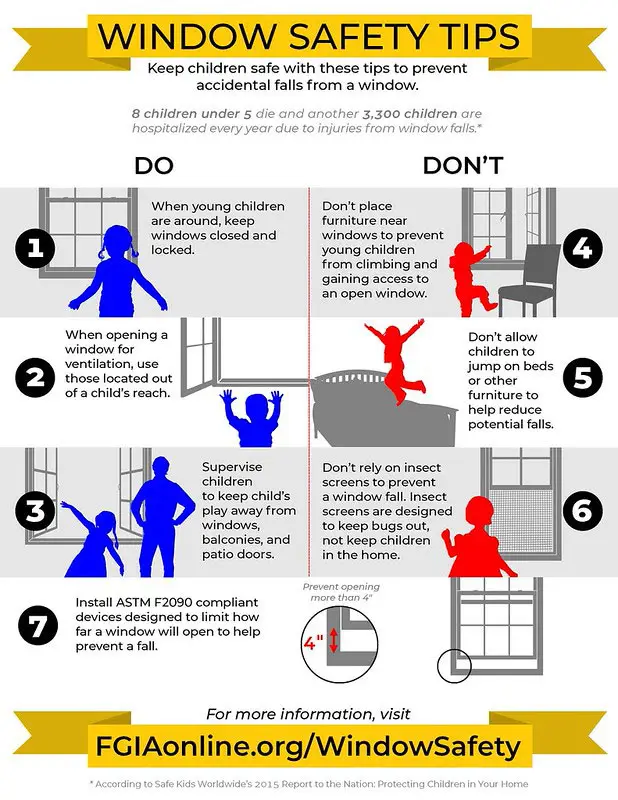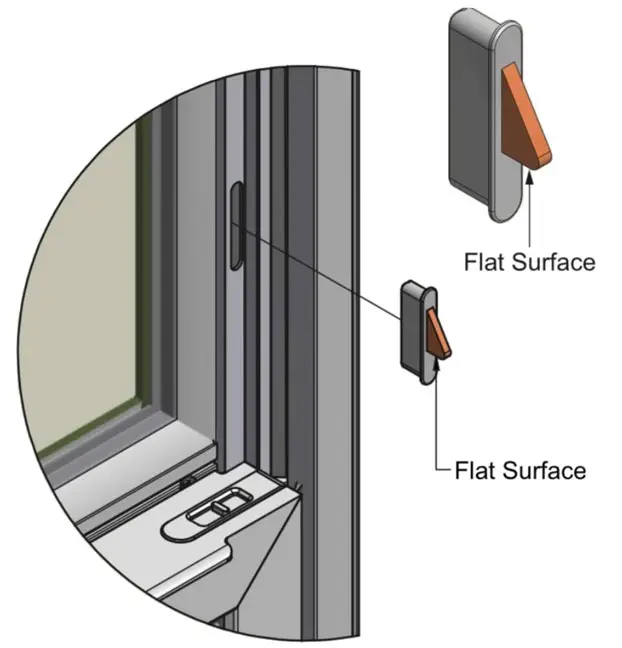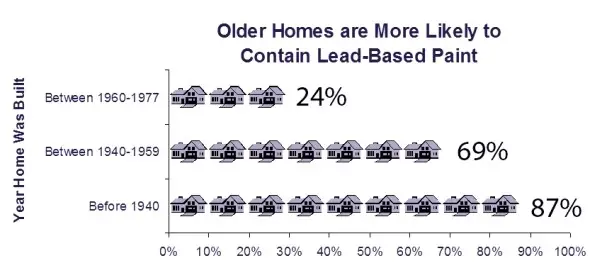It’s National Window Safety Week! This week is all about helping families learn how to prevent falls from windows as well as using windows to escape during an emergency. It’s a popular time for spring window replacement during the month of April, and you’ll move into the month well-informed on safety features for custom spring window designs.
Table of Contents
With the spring rains approaching, many homeowners also find this is when they notice water coming in through window, making it the perfect opportunity to address both safety and maintenance concerns.

Windows can serve as a lifeline to your family in the event of a house fire. However, it’s easy to overlook the potential danger of windows in our homes. After all, they provide such great natural light, fresh breezes, and even help us save energy!
Parents must be extremely aware of unattended open windows, especially for children. It’s a scary statistic, but roughly 5,000 kids fall from windows each year. That’s why it’s important to increase window safety in your home.
What is National Window Safety Week?
Established in 1997, Window Safety Week is a campaign that aims to increase awareness about the potential dangers to open windows. It also focuses on home safety and security, including the use of window safety devices to prevent injury and protect homes from burglars and intruders. The concept of this week comes from NSC and the Window Safety Taskforce.
During Window Safety Week, the American Academy of Pediatrics (AAP) encourages parents to take the following five steps to increase window safety in their homes:
- Install locks on all window openings.
- Make sure screens are in good working order. Consider FlexScreens that provide safety for children and also give you great visibility as well as protect your home from insects.
- Use curtains or shades to keep children from opening windows
- Consider using a baby gate to prevent access to high places
Let’s discuss each of these points in detail to help you better protect your family.

Window Safety Tips From Local Window Installers

Install Locks on All Window Openings
No matter if you live in an apartment or a house, all of the windows in your home should be equipped with locks. This includes the basement windows, hallways, and any other windows that your children could access.
If your window locks aren’t working, you’ll need to consider replacement as soon as possible. Finding replacement windows with quality locks is key to window safety.
Common Types of Lock Options for Replacement Windows
Did you know that each style of window has its own lock that works best? When you install new replacement windows, the locks are an often-overlooked aspect of high-quality spring window installations.
Generally, heavy-duty cam sweep locks hold sashes in place during violent weather and also provide intruder-resistant protection.
Meanwhile, some of the most common window locks include:
- Sash locks: These locks are common on double-hung windows. Crafted from two pieces and made from metal, you’ll turn a crescent-shaped piece to lock the window in place. These are a safe option and provide great security to windows.
- Window latches: If you want a visually pleasing and secure window, you’ll want to consider window latches. Vinyl windows will typically use latches that closely resemble window sashes.
- Window stays: Window stays are items that support open windows and also maintain the security of closed windows. Available in a variety of finishes, these window stays provide a neat finish and offer the security you need for your home.
- Vent limit latches: This proprietary Q4 locking system provides a wood-like look without the unsightly tilt latches.

One major benefit of upgrading your windows is improved home security. The locks and latches are sturdier and more durable, ensuring that the windows. By using sash locks, latches, and stays, you can enjoy a secure window with complete peace of mind.
What are the Best Childproof Window Locks?
While all window locks can provide protection, vent limit latches are perhaps the very best for families with children.
You can minimize the risk of children falling out of windows. However, the risk becomes much greater if the opening control device is not installed correctly.
Keep in mind that you can’t go to the hardware store and buy vent limit latches. These are factory-installed on your windows, engineered with a 4″ clearance. This means that it will not allow items (or children!) to pass through any space in the window opening after the window fall prevention device is in place.
Window Leak Repair: Beware of the Dangers of Lead Paint

If you live in an old home, you might have peeling and chipping paint around your windows. This type of issue is different than moisture damage, as it signals that you have lead paint in your home.
If you’re not sure whether the paint in your home is lead-safe or not, you can test it to find out. You can also hire a lead-testing lab to perform the tests for you. However, you should remember that even if the walls don’t have lead in them, the dust from the walls can still pose a danger. So when in doubt, you should assume that the walls are contaminated and keep your child away from it.
Symptoms of Lead Poisoning
Lead poisoning is a very serious concern. The symptoms in children are as follows:
- Developmental delay
- Learning difficulties
- Irritability
- Loss of appetite
- Weight loss
- Sluggishness and fatigue
- Abdominal pain
- Vomiting
- Constipation
- Hearing loss
- Seizures
- Eating things, such as paint chips, that aren’t food (pica)
Keep in mind that the issue isn’t only about ingesting the paint. Even the dust from lead paint can result in serious health consequences.
The best way to get rid of lead paint on your windows is to hire a Leaf Safe Certified window contractor. In the state of Massachusetts, homes that are built before 1978 may contain lead paint. As a Lead Safe Certified Contractor, Coastal Windows & Exteriors knows how to safely replace windows with lead paint.
Make Sure Screens Are in Good Working Order
A broken or malfunctioning window is a gateway for intruders and insects. Make sure all of your windows have been treated for bugs. You can also use an air purifier to rid your home of allergens and particles in the air.
Meanwhile, FlexScreen is extremely damage-resistant, protecting it from dents and breaks no matter what gets thrown at it. It’s engineered with a powder-coated steel frame on the screens are tough and scratch-resistant. The impact-resistant engineering also allows it to serve as a safety feature for windows, all while providing you with impeccable visibility and defense against insects.
With the flexible material of Flex screen, the design allows for quick installation without any complicated removal methods required.
Use Curtains Shades to Keep Children From Opening Windows
Curtains and shades can prevent children from seeing outside and falling or climbing out of windows. This is especially important during the warmer months when windows are typically left open.
Shades and curtains can be used to satisfy the sun-protection aspect of window safety in addition to keeping kids out of sight.
Beware of using blinds around young children. Roughly 10 children under 5 die each year from strangulation by way of blind or drapery cords. Choose cordless window blinds in place of traditional ones to eliminate the risk of strangulation.
Consider Using a Baby Gate to Prevent Access to Windows
A baby gate is a great way to prevent access to areas with windows. It is essentially a gate that clips onto the wall next to a staircase or a landing.

The gate is used to restrict access to an area and is a great way to prevent kids from climbing or accessing areas with windows. Plus, installing a baby gate does not require a lot of extra effort or time for parents.
This means that you absolutely must have windows with vent limit latches installed for childproof locking.
Using Windows as a Fire Escape
The other aspect of Window Safety Week is using windows as a fire escape. Windows are often the only way you can get out of your house if there is a fire. You typically have about 3 minutes to escape, and windows are often more accessible than doors.
In some homes, it may not be possible to use stairways because they have already been consumed by flames or smoke, and hallways may also offer limited exits for those on upper floors.
The following characteristics help determine if the window is adequate to use as a fire escape path:
- Easy to open: Escape windows should not require you to break glass as you make an exit. The window should be quick to open and not contain any broken parts, or pose injury threats such as exposed clips, nails, and screws.
- Window height: The window needs to be large enough for an adult to fid on the outside of a window.
Some of the best windows to use as escape routes during a fire include swing-in awning windows, casement windows, slider windows, and double-hung windows. You should avoid using hopper windows or awning windows that swing open at the top of the frame.
As always, test your smoke alarms and replace the batteries at least once a year.
Dealing With Water Coming In Through Window
Spring rains often reveal window problems that may have gone unnoticed during other seasons. If you’re experiencing water coming in through window frames, it’s important to address this issue quickly. Not only can water ingress damage your home’s interior, but it can also lead to mold growth and structural problems over time.
When you notice leaks around your windows, it’s best to contact a replacement window installer near me rather than attempting DIY fixes that might not provide lasting solutions. Professional window installers have the expertise to properly diagnose the source of leaks and recommend appropriate repairs or replacements.
Quick Q&A About Window Safety and Maintenance
When is National Window Safety Week?
National Window Safety Week is observed annually during the first full week of April. This timing coincides with the spring season when many homeowners begin opening their windows after the winter months, making it an ideal time to emphasize window safety for families.
Why is there water on the inside of my windows?
Water on the inside of windows can be caused by several factors. Condensation forms when warm, moist indoor air contacts the cooler glass surface, especially in winter or in high-humidity environments.
However, if you notice water pooling on window sills or dripping down walls, this likely indicates a leak in the window seal, frame, or installation. It’s a sign that you need professional window leak repair to prevent water damage to your home.
How to seal old windows?
While there are temporary DIY solutions like using weatherstripping, caulk, or plastic window insulation kits, these are not permanent fixes for seriously deteriorated windows. For lasting results and proper insulation, it’s strongly recommended to contact professional local window installers.
DIY approaches often fail to address underlying structural issues and may even trap moisture, causing more damage. A professional window service can properly evaluate your windows and provide solutions that will prevent leaks, improve energy efficiency, and enhance your home’s comfort and value.
National Window Safety Week: Improve Home Safety with Spring Home Window Upgrades
If your windows are a safety concern and do not fit the proper protocol for a fire escape, please contact us to discuss replacement. Windows that are hard to open and close or contain exposed screws need a swift replacement for your safety.
As National Window Safety Week reminds us, windows play a crucial role in both home safety and comfort. From preventing falls to serving as emergency exits, from stopping water coming in through window frames to protecting against intruders, properly maintained and installed windows are essential. Whether you need window leak repair or are considering a full replacement, consulting with qualified local window installers is the first step toward creating a safer home environment for your family.
Get in touch with us today for a free quote and to see a free 3D preview of your home with new windows.





